|
 Dwight Peck's personal website Dwight Peck's personal website
Sirmione and the neighborhood, May 2016
Ten days in the home of the Scaligeri and the heretics
You may not find this terribly rewarding unless you're included here, so this is a good time for casual and random browsers to turn back before they get too caught up in the sweep and majesty of the proceedings and can't let go.
Mantua (1): Piazza Sordello, Sant'Andrea, Ducal Palace
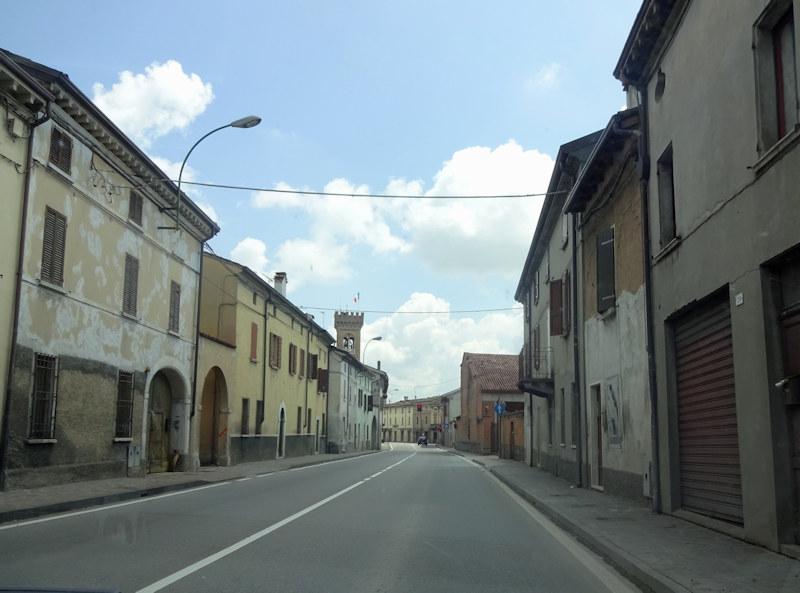
We're entering downtown Mantua, or Mantova, after a one-hour's drive due south on back roads from Sirmione, 15 May 2016.

A good parking spot next to the gardens of the Piazza Virgiliana, a large public space built onto an infilled swamp leaking over from the Lago di Mezzo, just behind those trees, the middle of the three humanmade lakes that surround the city on three sides formerly for defensive purposes.

A place of honor for the statue of Virgil (Publius Vergilius Maro), the great Roman poet born in 70 BC in a village near Mantua, who (as evidenced by his poems) remained devoted to the city all his life.

The lovely park was commissioned in 1797 by the French general de Miollis, who'd participated in the siege of Mantova in that year (and in the American Revolution 16 years earlier), in order to honor the renowned poet Virgil and assist the citizens in warming up to the French occupation a little more. The present statue of Virgil was inaugurated in 1927.

A Google maps screenshot of the centro storico of Mantova, with the river Mincio (flowing from Lago di Garda to the Po) intercepted here and widened and dammed in the late 12th century into three lakes that helped to protect the city from unapproved visitors.
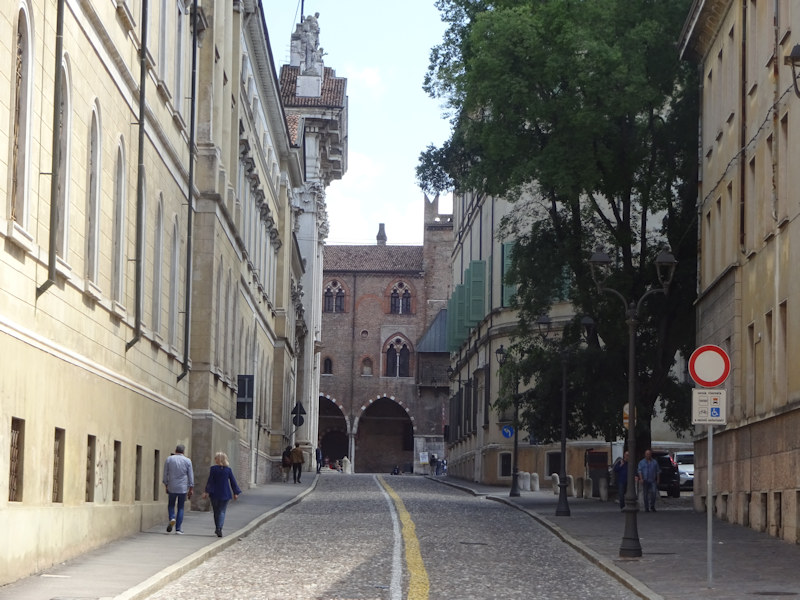
We process up the Via Fratelli Cairoli (named for a family of freedom fighters, some of whom accompanied Garibaldi's Expedition of the Thousand in 1860), approaching the Ducal Palace from the Piazza Virgiliana.
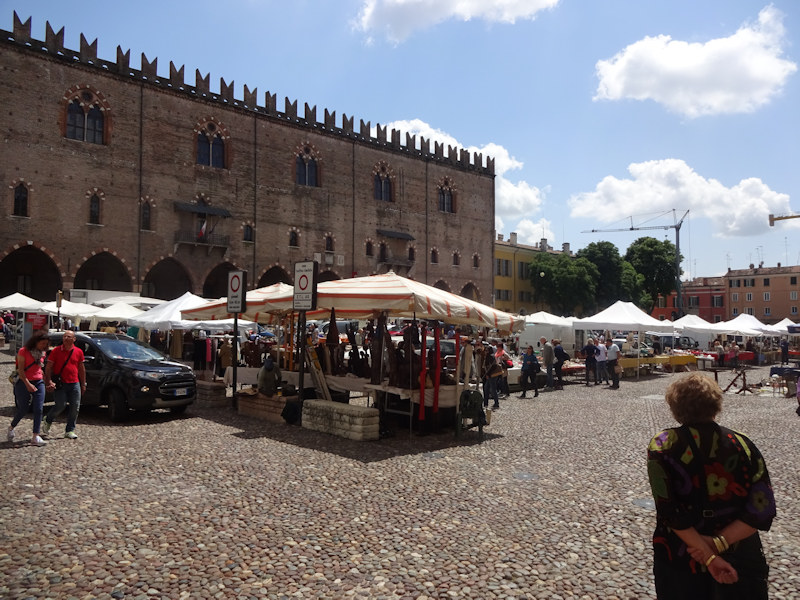
Street market day in the Piazza Sordello, created in 1330 by knocking down some parallel streets -- originally named St Peter's Square, how original, but later wisely renamed for the high-spirited 13th century troubadour poet Sordello born near Mantua, who kidnapped Cunizza his boss's wife in Verona, encouraged by her brother the infamous Ezzelino da Romana, and seems to have been on the run for the rest of his life. He was made famous by Dante Alighieri and Robert Browning.
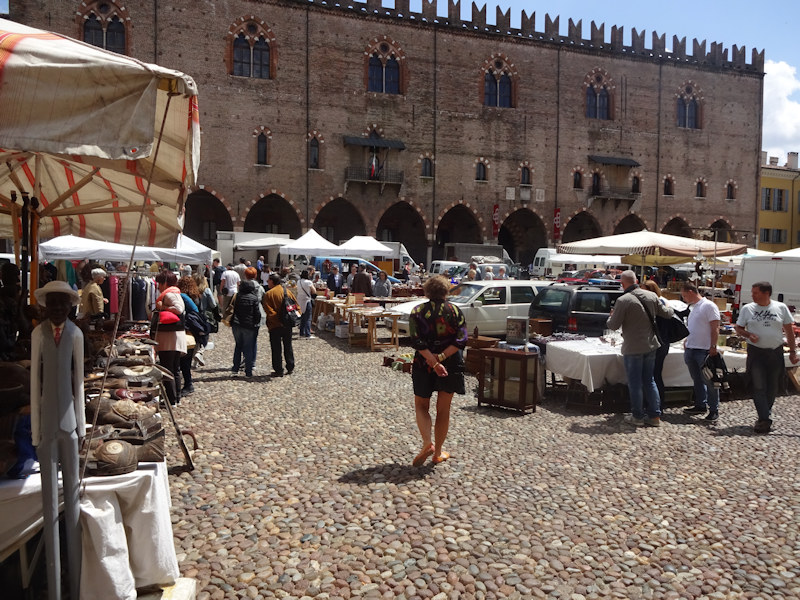
The Gonzaga's Ducal Palace looms behind, specifically the part of it called the Palazzo del Capitano. Mantua began as an Etruscan village and progressed to a Roman settlement for military veterans. In late- and post-Roman days, it suffered the usual vicissitudes of northern Italian towns at the hands of the Ostrogoths, Byzantines, Lombards, and Franks, but after nearly a century under the rule of Boniface of Canossa, the Margrave of Tuscany, and his amazing daughter Matilda, the "Gran Contessa", after her death in 1115 the city became a free commune.
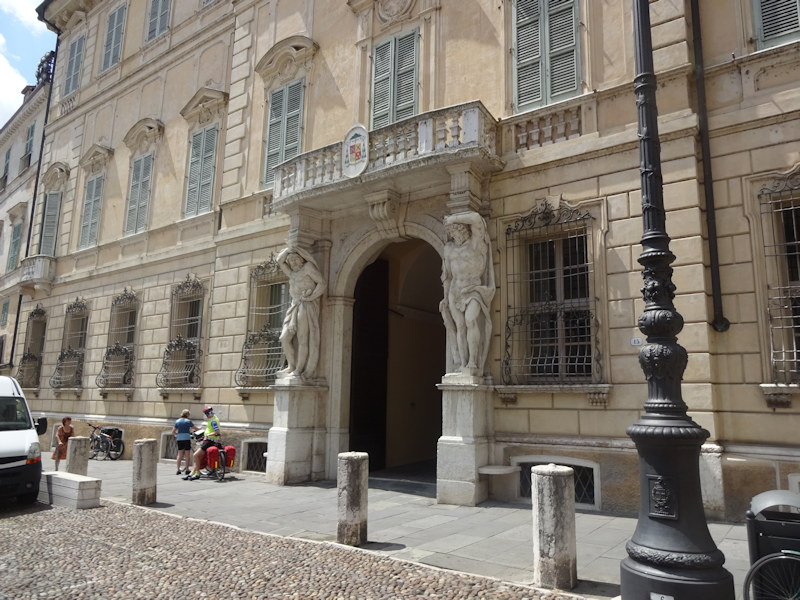
The Palazzo Vescovile or Bishop's Palace, built as a family home in the late 18th century, with two huge telamons holding up the balcony. In 1328 the Gonzagas orchestrated a civic revolt against the predominant Bonacolsi family (with the help of the Veronese Scaligeri) and proceeded to lead the city, politically and culturally, for the next 300 years. Isabella d'Este, wife of Francesco II Gonzaga, Marquess of Mantova, in the early 16th century, was one of the foremost art patrons and style-setters of the Renaissance in Italy, and many of the Gonzaga menfolk figure prominently in the military to-ing and fro-ing of the times; her third son, Ferrante I Gonzaga, brother of Duke Federico II, was a successful mercenary commander, a right-hand man of the Emperor Charles V, and one-time imperial ambassador to Henry VIII of England, in 1543.
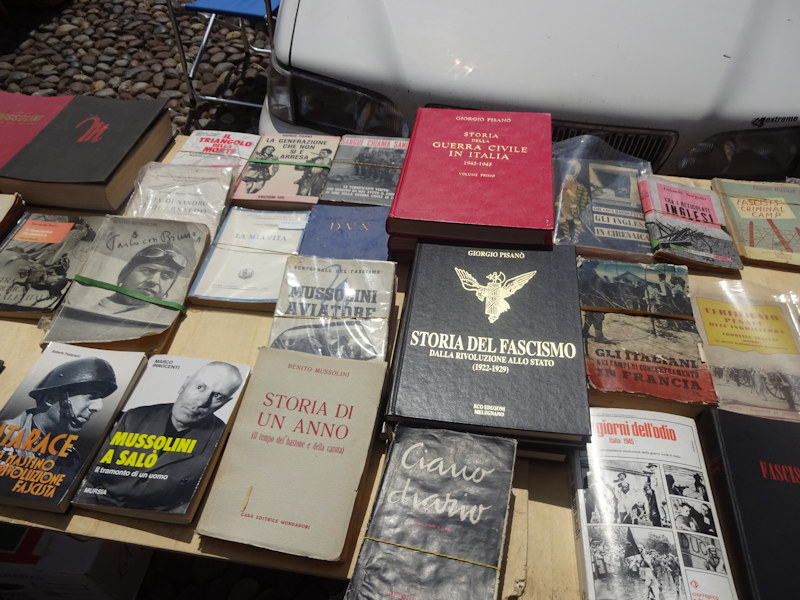
The Piazza Sordello street market: get your Fascist memorabilia here!
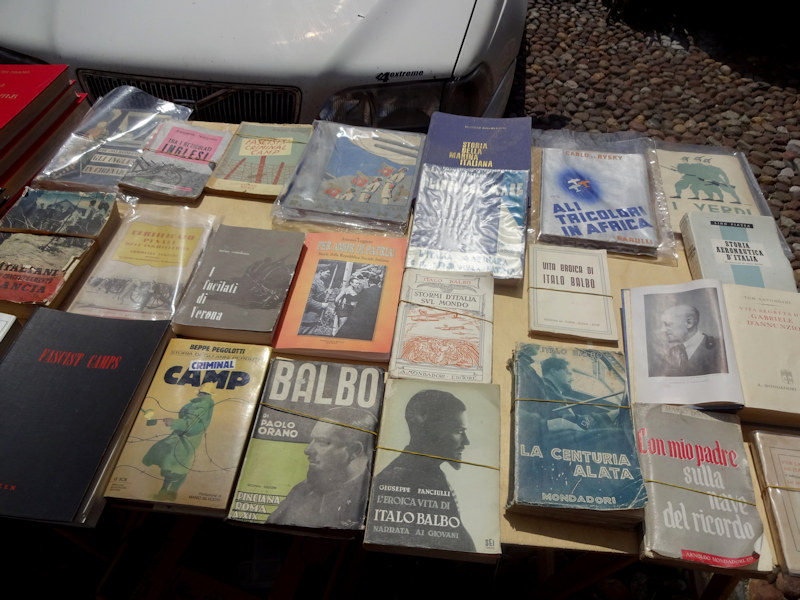
Specializing in Balbo, Mussolini's "heir-apparent" until he was shot down by 'friendly fire' in 1940.
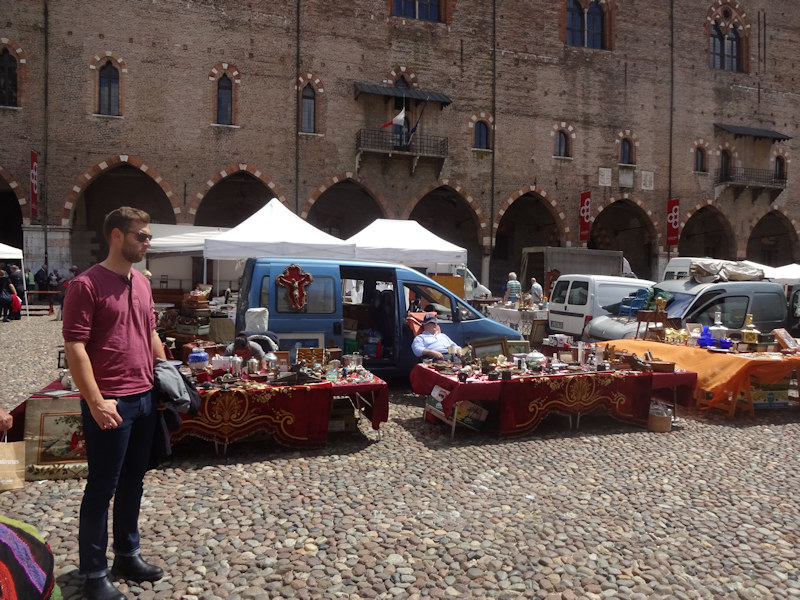
A sleepy Sunday on the Piazza Sordello in Mantua. Amongst artistic worthies who worked in Mantova during the Gonzaga ascendancy were Pisanello, Mantegna, Leon Battista Alberti, Giulio Romano, Rubens, Monteverdi, and Correggio.

The late-14th century Duomo, the Cattedrale di San Pietro apostolo, with its mid-18th century façade. We'll come back.
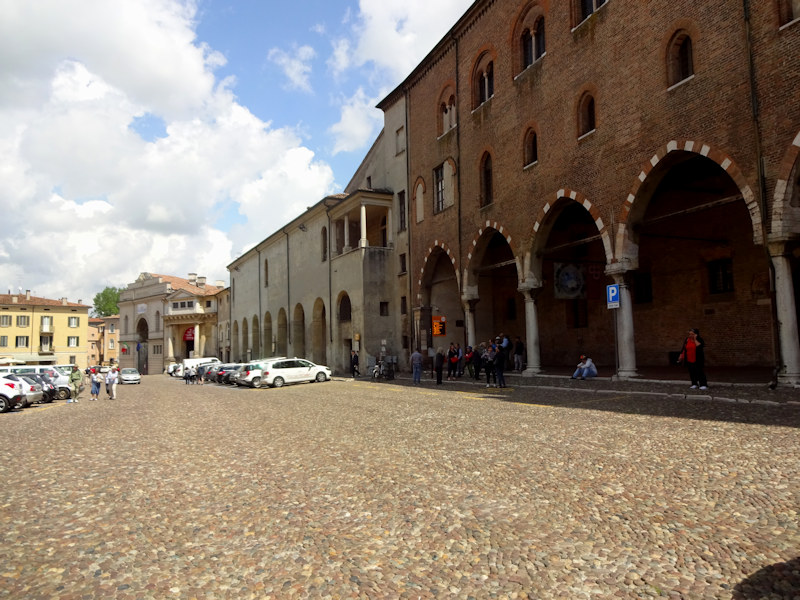
The Ducal Palace; we've taken our entrance tickets and promised to turn up at the right time. In 1530, Federico II Gonzaga was created Duke of Mantua by the Emperor Charles V, and in 1531 the family acquired the Marquisate of Monferrato, in the Piemonte region, as well, this time by marriage.
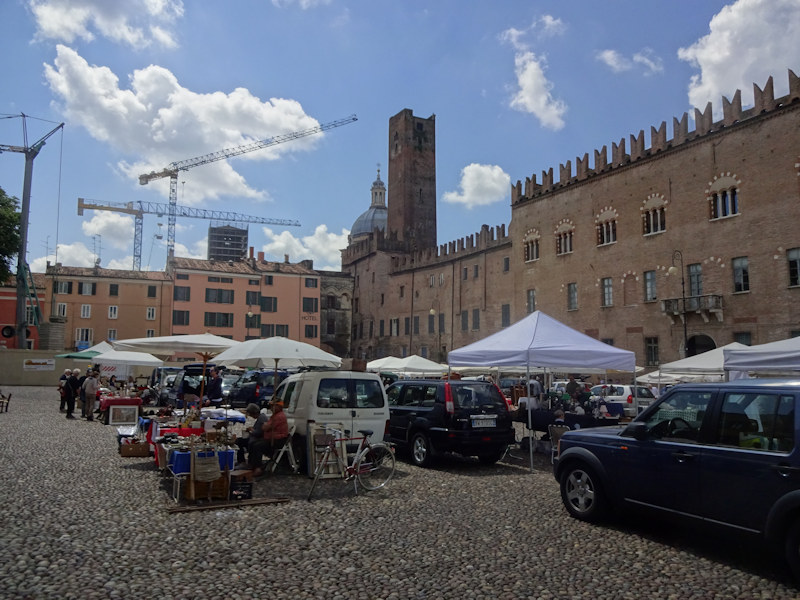
The Piazza Sordello, the late 13th century Palazzo Castiglione (formerly mistakenly called the Palazzo Bonacolsi) on the right, and its Torre della Gabbia, or 'Cage Tower'. Following the death in 1627 of the last male Gonzaga of the direct line, the title was inherited by a cadet branch in France, the Gonzaga-Nevers; this was contested in the "War of the Mantuan Succession", which quickly turned into a France-Habsburg proxy war. An imperial army of German mercenary Landsknechts besieged Mantua from late 1629 to July 1630, then brutally sacked it in the middle of a bubonic plague epidemic, but was then called northward by other developments in the Thirty Years' War.

The Austrian Habsburgs took over Mantova in 1708 and held onto it until Napoleon besieged the city in 1796-97, and then regained it from the French in another siege and long artillery bombardment in 1799. After another brief period of French rule, the city was returned to Austria in 1814 -- it joined the new Kingdom of Italy with Venice in 1866.

Leaving the Piazza Sordello along the central Via Broletto

The Piazza Broletto façade of the Palazzo del Podestà is shrouded in scaffolding
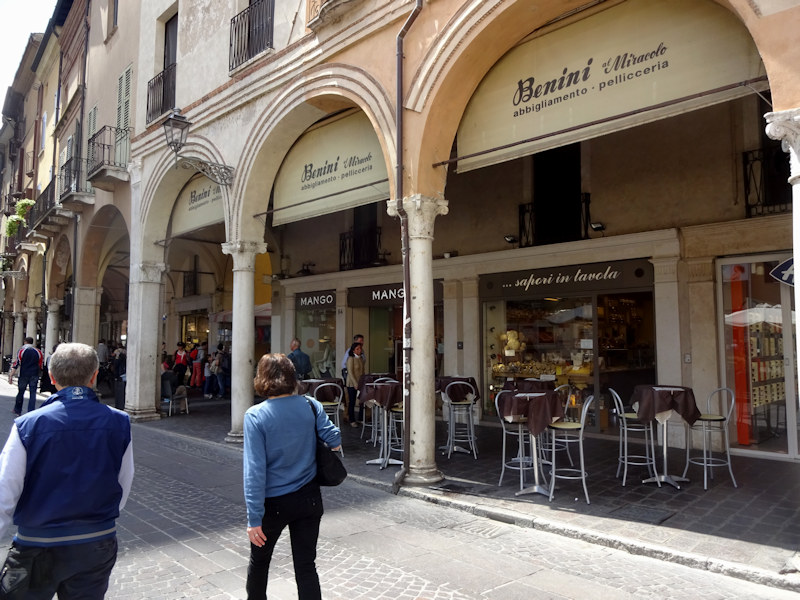
Along the Via Broletto
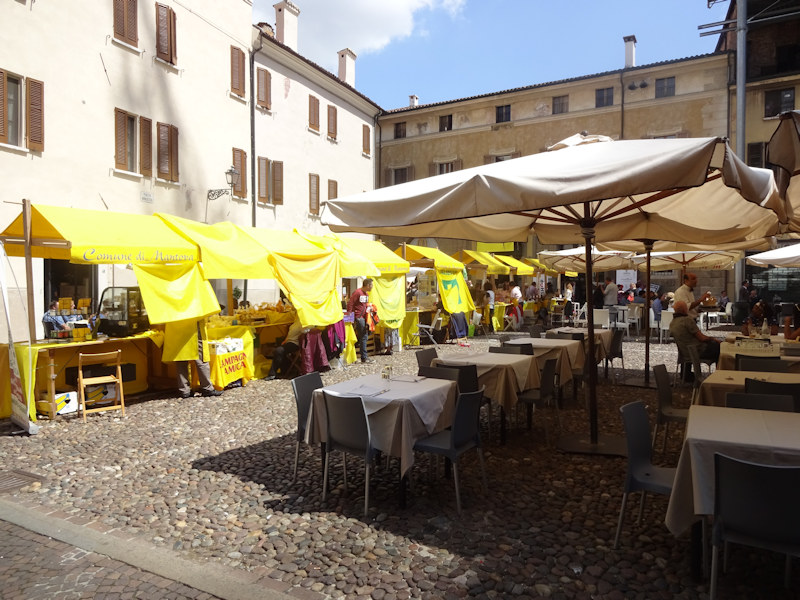
The Piazza Broletto ('broletto' refers to a civic meeting place in republican northern Italy)
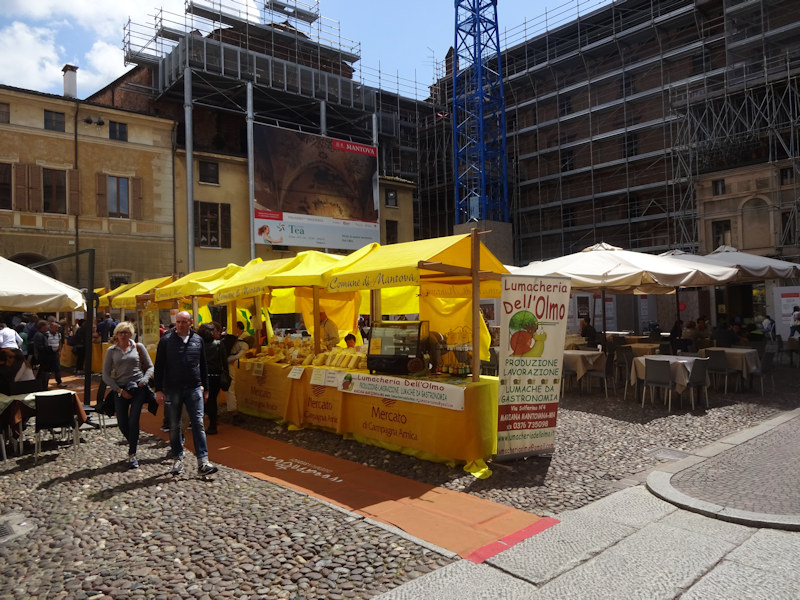
The Piazza Broletto, with the 15th century Palazzo del Podestà getting a facelift
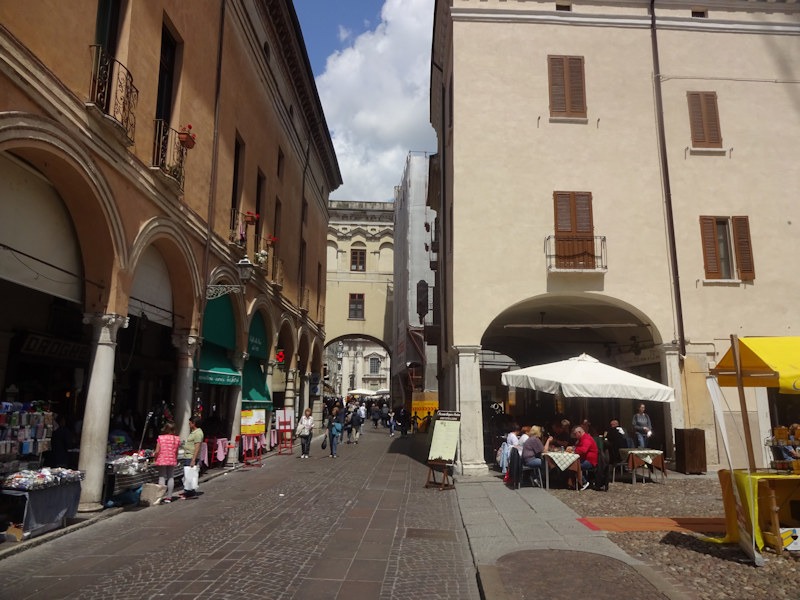
From the Piazza Broletto looking back toward the Duomo under the arch
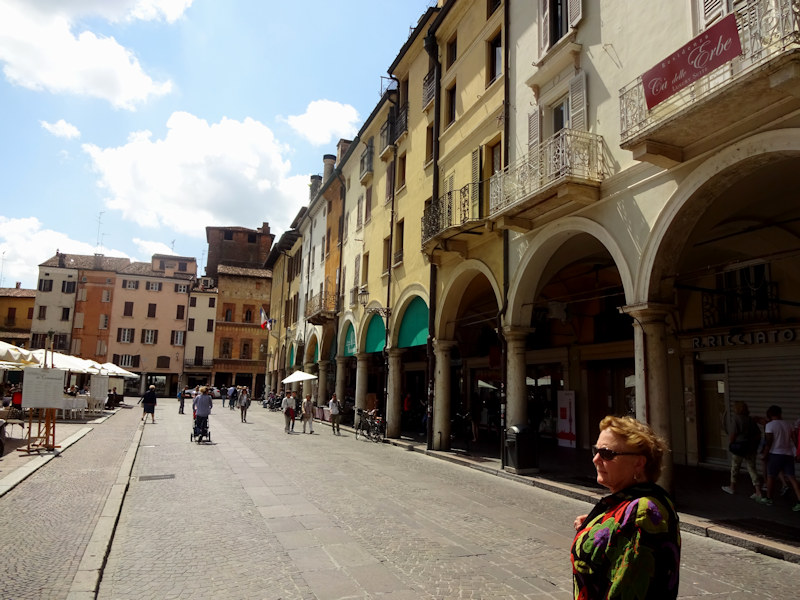
The Via Broletto in front of shops nestled up against the Sant'Andrea dome behind them on the right
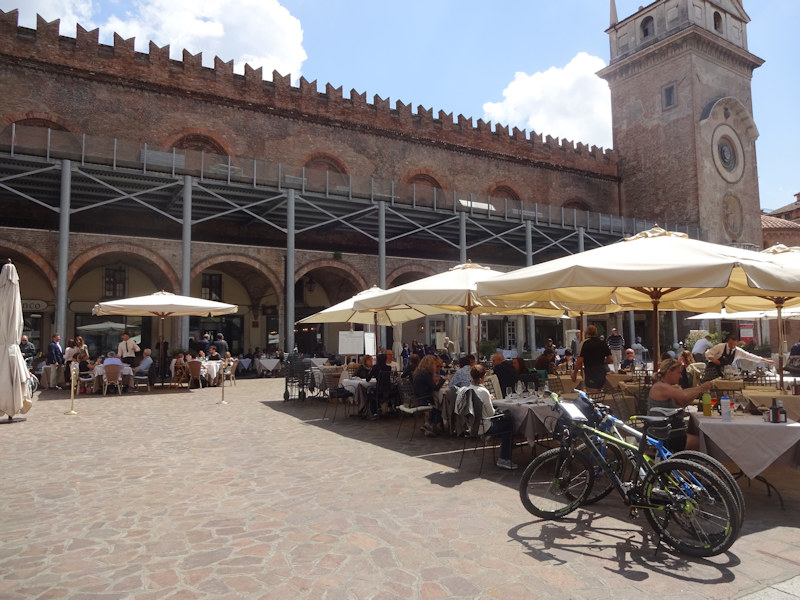
The Palazzo della Ragione, the name for a medieval town hall in the Veneto region, and the Palazzo delle Erbe, or medieval marketplace, with the clocktower in the background
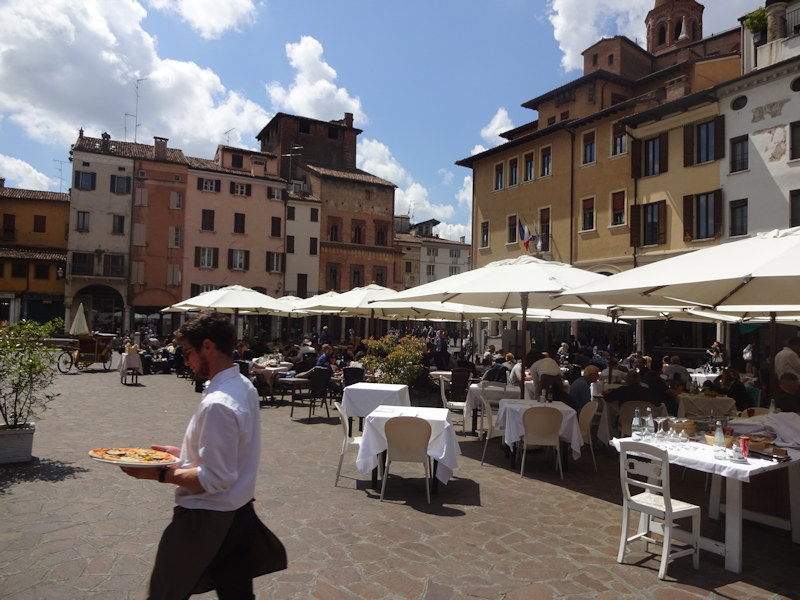
-- Who ordered the pizza?
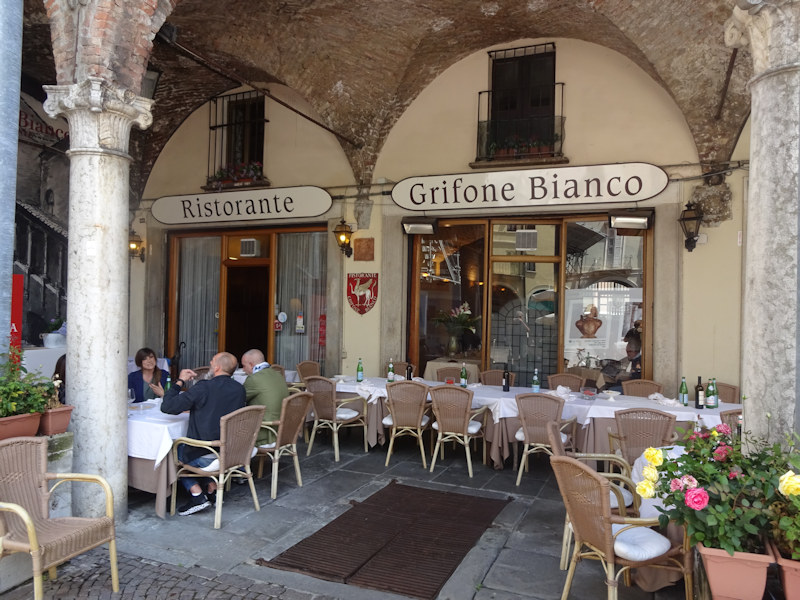
We were here about five years ago and had a favorite restaurant, which was fabulous except for the Frank Sinatra music, and now we're trying to recognize it amongst the restaurants along the Palazzo della Ragione. That's not it.
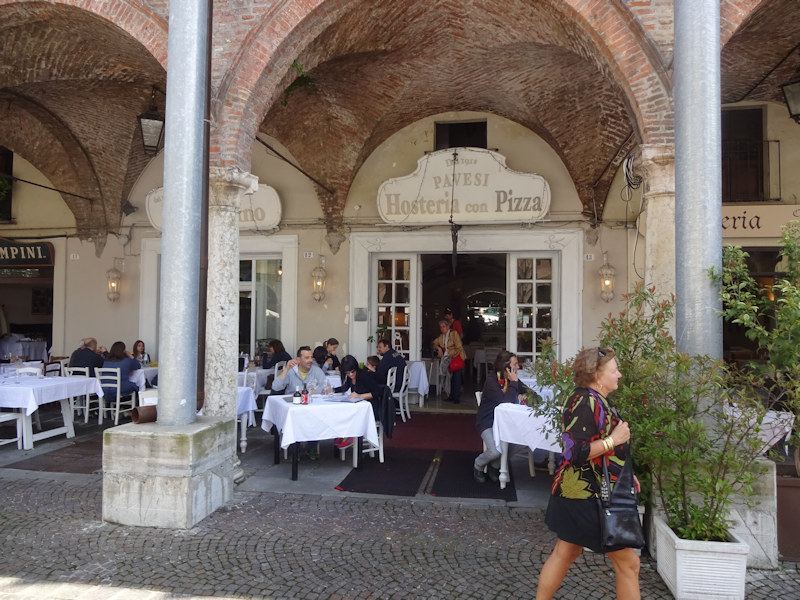
That's not it either.
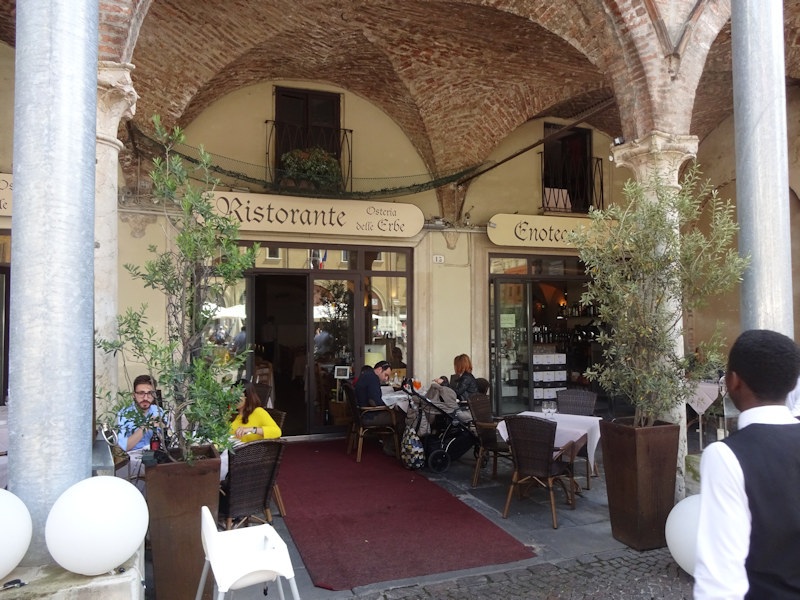
Nor that one.

This is it, or was it, in 2011 -- the Masseria, with remains of early frescoes on the walls; our search was off by one piazza. |
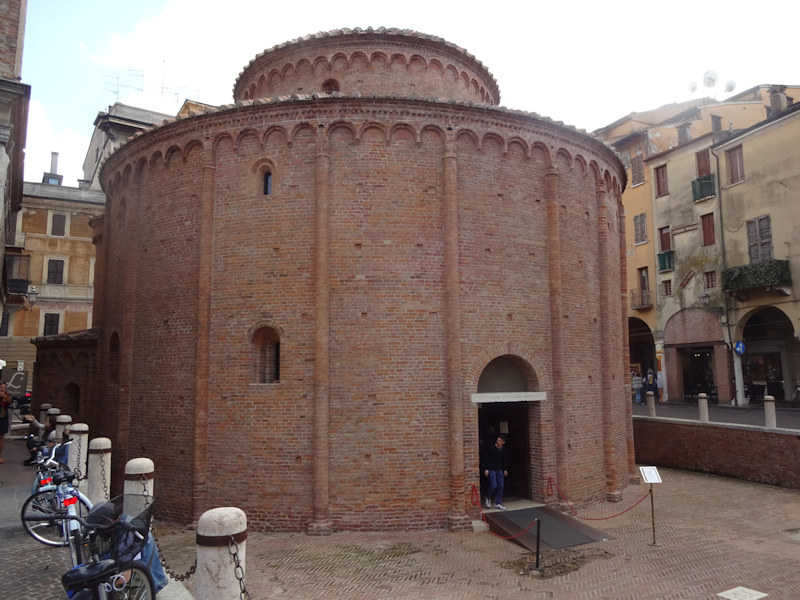
This is the Rotonda di San Lorenzo alongside the clocktower, settled nicely on the street level at the time it was built by the Canossa family in the late 11th century, probably commissioned by Matilda the Gran Contessa herself.

It's modeled on the Church of the Holy Sepulchre in Jerusalem and devoted to San Lorenzo, or St Lawrence, him of the hot gridiron, said to have been martyred during the persecutions of Valerian in 258. The upper floor is the matronaeum for the female churchgoers; around the walls there are some Byzantine-style frescoes from the 11th-12th century.
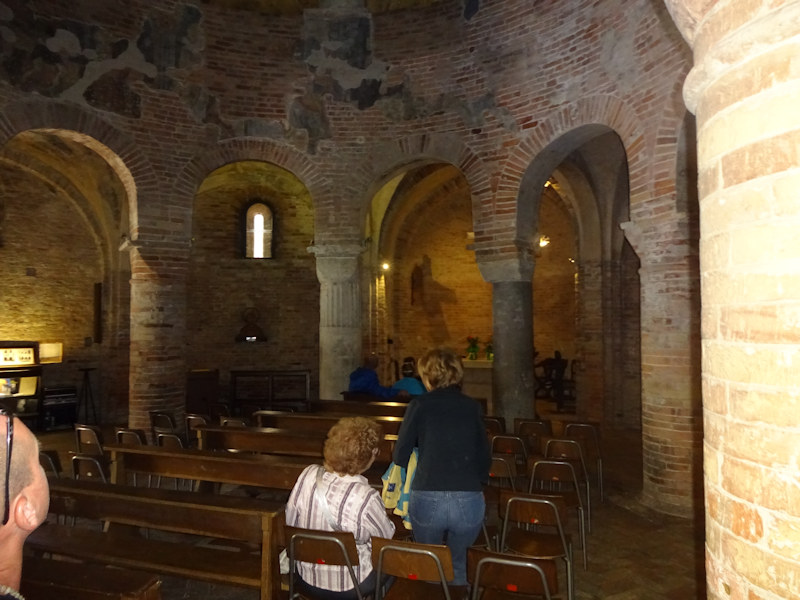
It's mostly made of brick in the Lombard style, but there are also a few marble columns, as here, scavenged from elsewhere.

The disgusting public fountain on the side of the clocktower
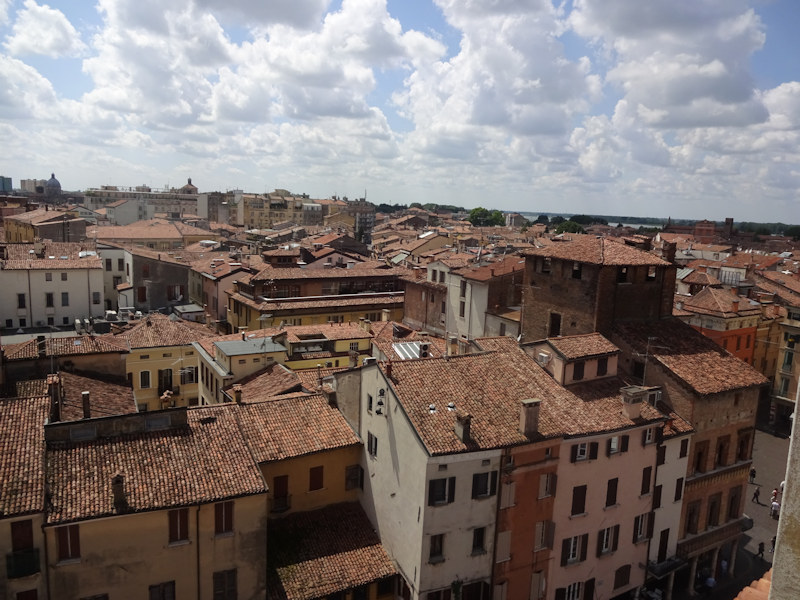
From the top of the clocktower, looking towards the Gonzagas' Palazzo Te (we didn't make it out there on this trip, but there are some photos from 2011 here).
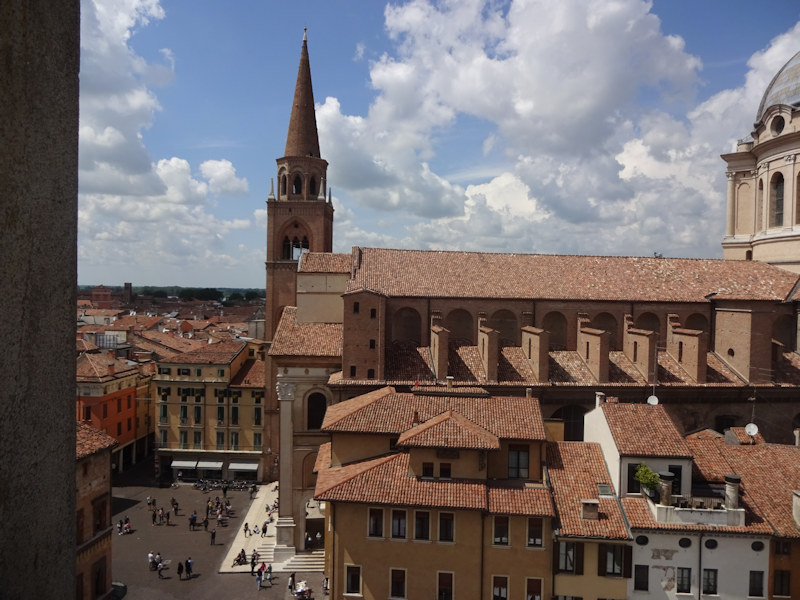
The 15th century Basilica di Sant'Andrea just across the way

The dome of Sant'Andrea, completed in the 18th century, looming over shops on the Via Broletto
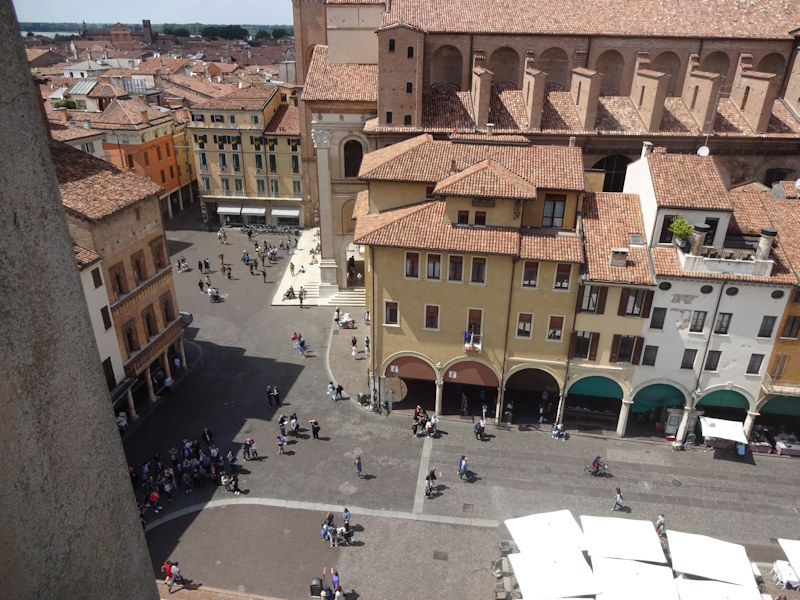
The Piazza delle Erbe below

The strange façade of the Basilica di Sant'Andrea, built of brick covered with stucco. It was commissioned by the Marquis Ludovico III and designed by Leon Battista Alberti in 1462, though it remained unfinished well into the 18th century.
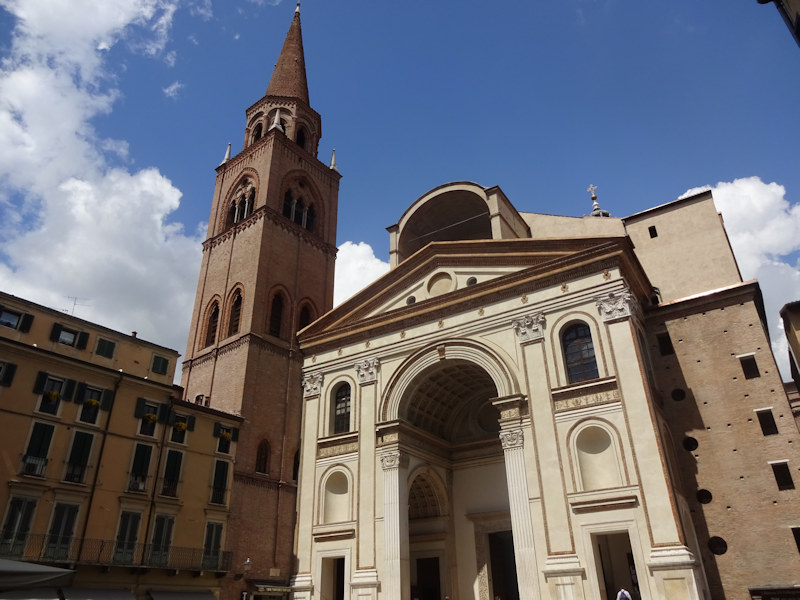
The façade of the Basilica and the 1414 belltower from a pre-existing Benedictine monastery on the site

A single nave with side chapels
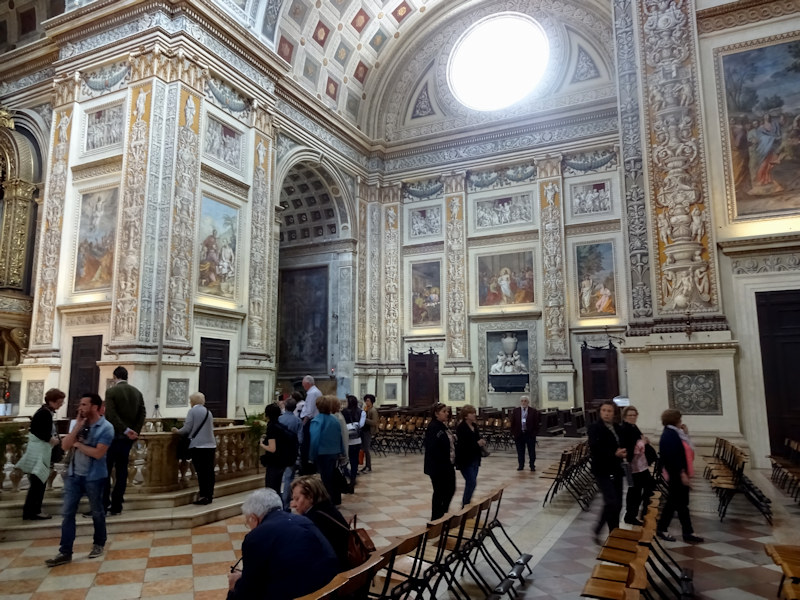
The arms of the transept were added in 1597.
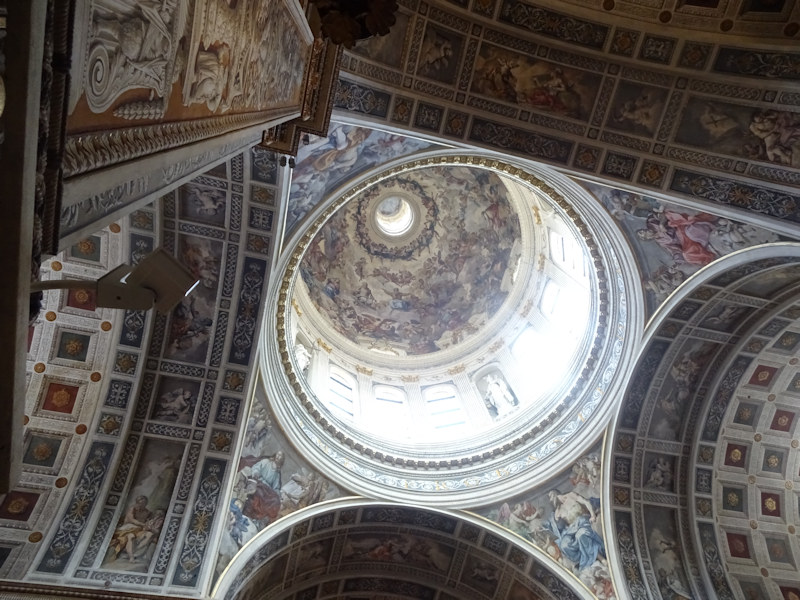
The dome and lantern, too, were added subsequently, constructed between 1732 and 1782.
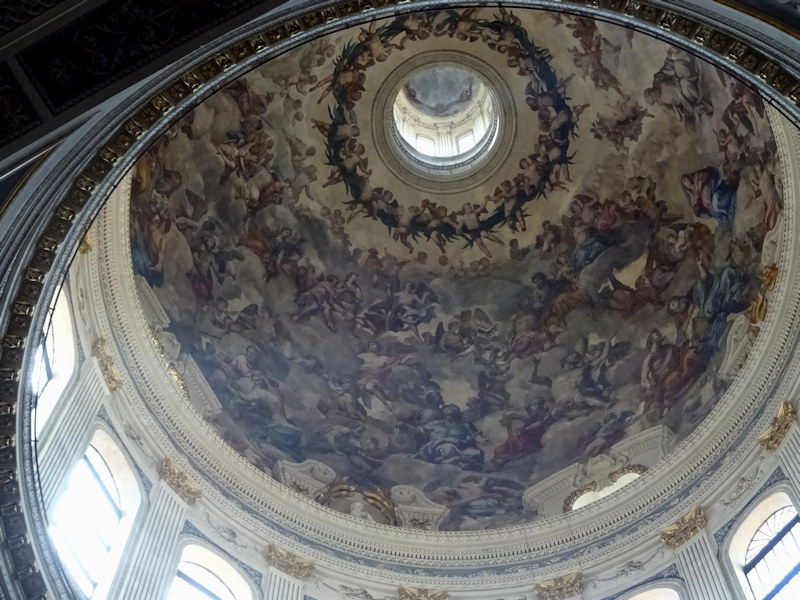
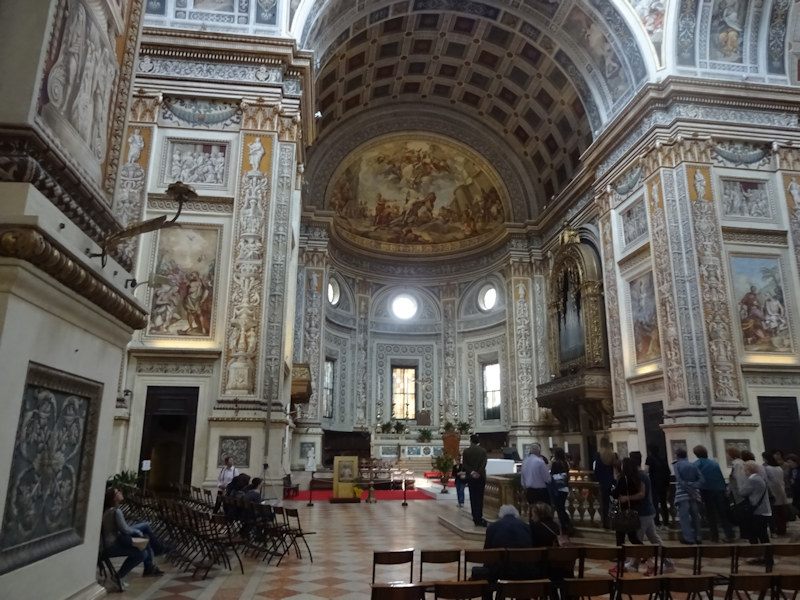
They've got Christ's Precious Blood here, too, in two "sacred vessels" that rise up from the crypt for the viewing of the faithful on Good Friday, through a hole directly below the cupola, presumably protected by that octagonal railing exactly in the crossing. By some good fortune, a Roman centurion (named Longinus) who attended the Crucifixion had the presence of mind to scoop up some of the blood-soaked soil beneath the cross and brought it along to Mantua. It's the real thing, too; Pope Leo IX authenticated it in 1053. (In 1054, he authenticated the "Donation of Constantine", an 8th century forgery which proved that the Emperor Constantine had presented political, temporal as well as spiritual authority over the entire western Roman empire to the Popes of Rome for all time, in gratitude for converting him to Christianity.)
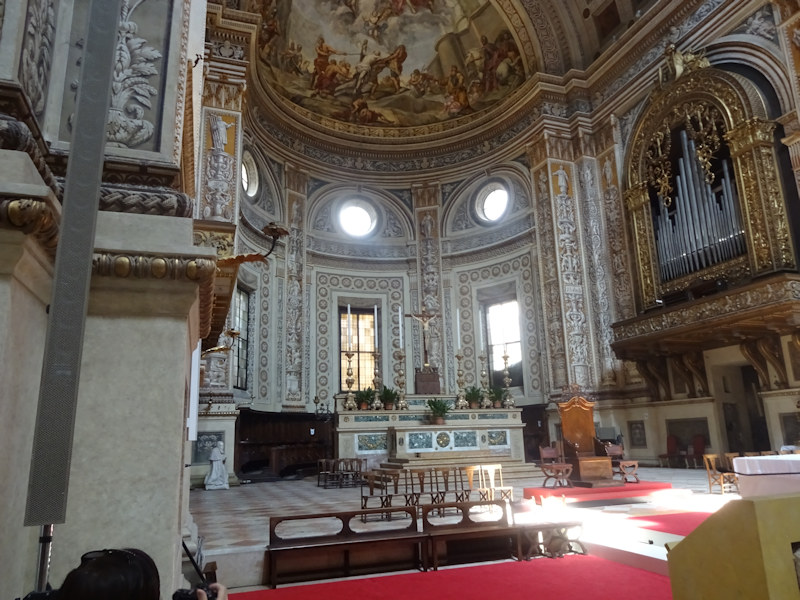
The altar and chancel
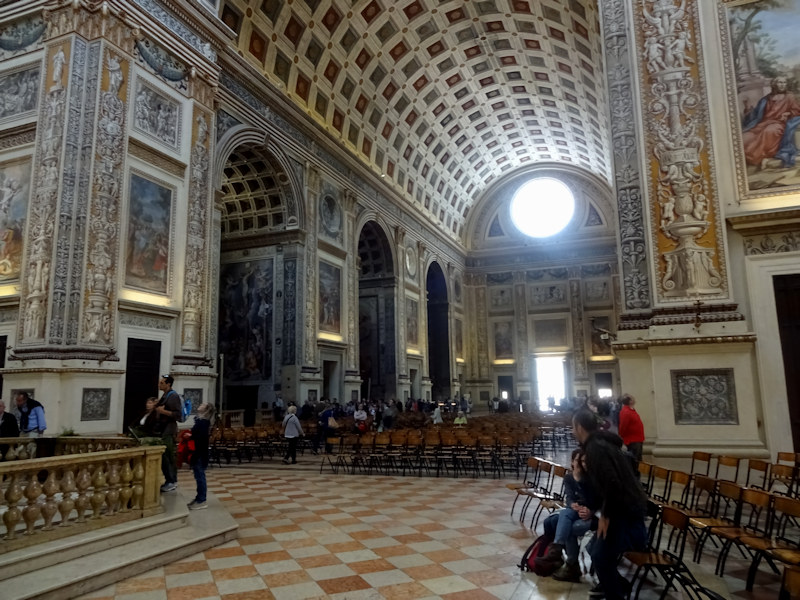
Apparently, Alberti's design called for a coffered ceiling, but cost implications intervened and the coffering was painted onto the barrel vault.

Mantegna's in one of those chapels, as is Federico I Gonzaga, Marquess of Mantua.
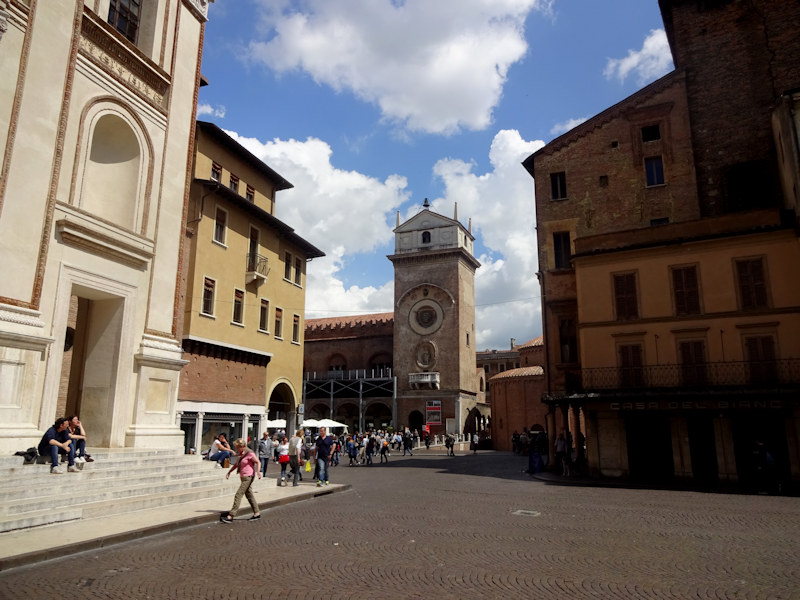
The civic clocktower and Rotunda from the Piazza Andrea Mantegna in front of the Basilica Sant'Andrea
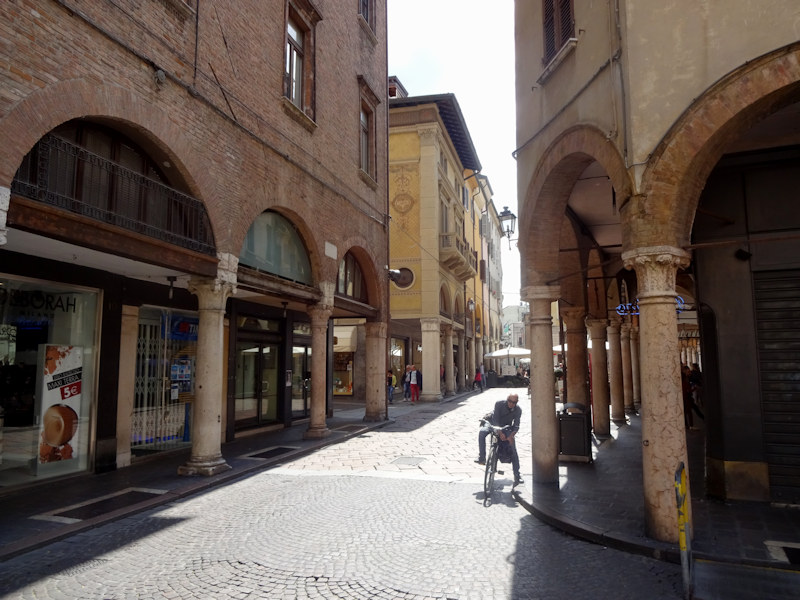
The Via Roma leading from the Piazza Mantegna southwestward towards the Palazzo Te
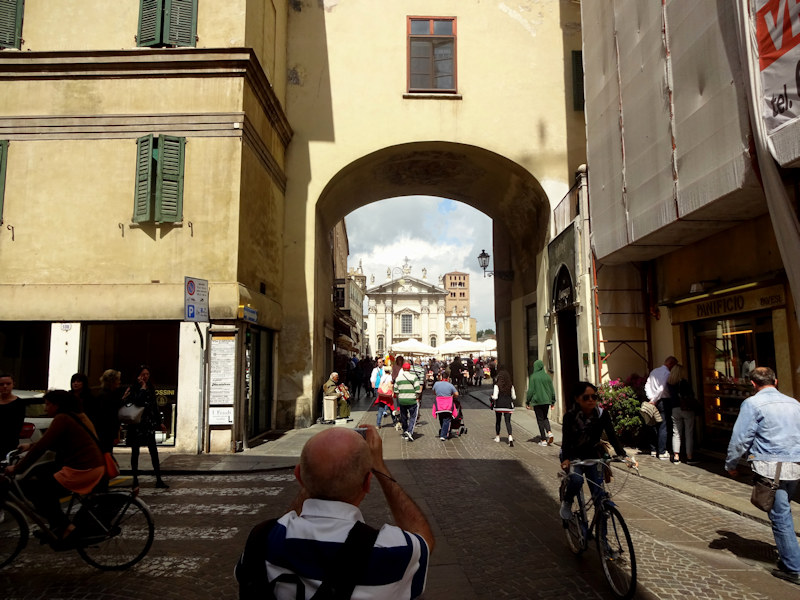
I've lost my traveling companion, who was lunching, so I rush towards the Piazza Sordello.
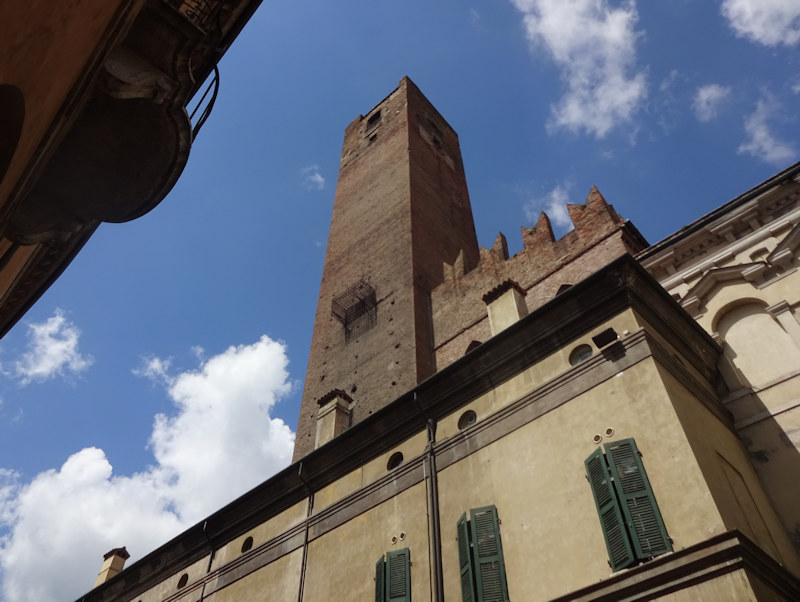
Torre della Gabbia, or the Tower with the Cage on it (see it up there?). The tower dates from 1281, but the cage for exposing bad people was added in 1576 by Guglielmo Gonzaga, the first Duke from 1574. According to Wikipedia, it was also used to execute "a Dominican monk arrested in a house of ill-repute, after giving mass despite being illiterate".

The Ducal Palace again, across the Piazza Sordello. Our time has come. The Palazzo Ducale is a vast complex of palaces of the Bonacolsi and later Gonzagas, dating from the late 13th to the 17th century. It includes the semi-detached Castello di San Giorgio from about 1400, which is closed off except for Mantegna's Painted Chamber, the Camera degli Sposi or Bridal Chamber, which we'll see presently.
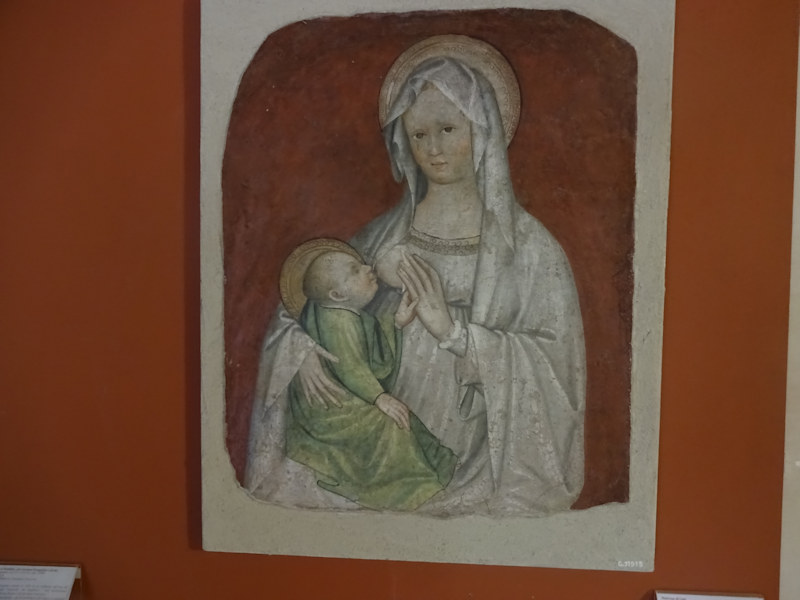
At the moment, probably in the Palazzo del Capitano (or perhaps the Magna Domus?), here is another contender for our photo collection of Madonnas with anatomically awkward nursing methods (Madonna del Latte, ca. 1410).
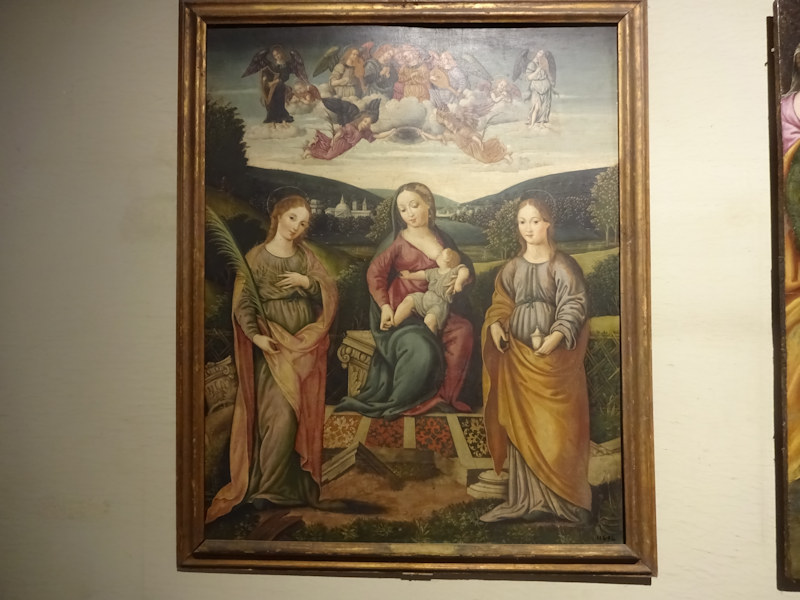
A nice Madonna and child with Saints Catherine and Mary Magdalene (Maestro di San Vincenzo, ca. 1520)
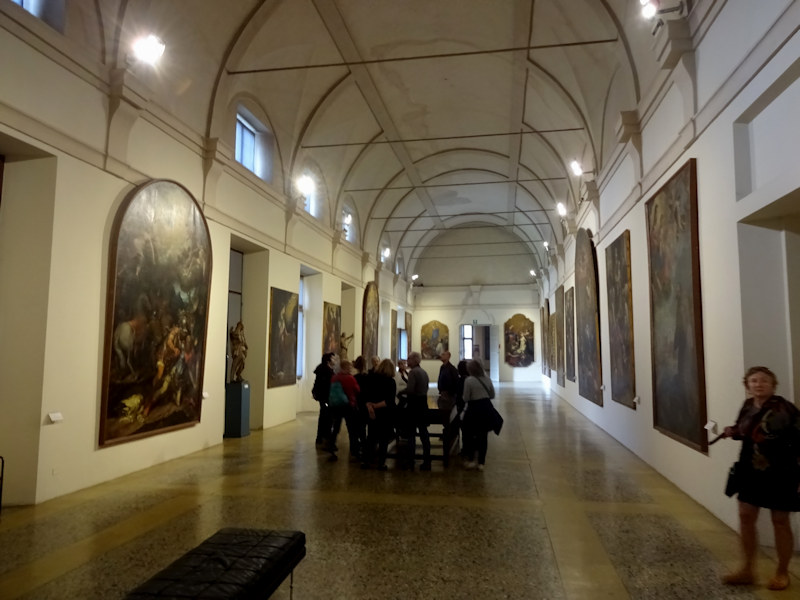
An excellent venue for a gallery, but not so good for a family home. Even a ducal one.
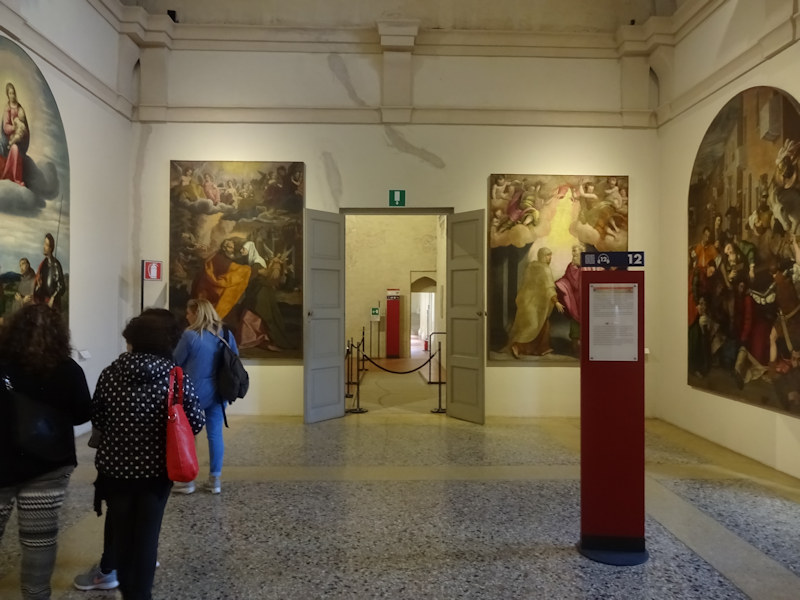
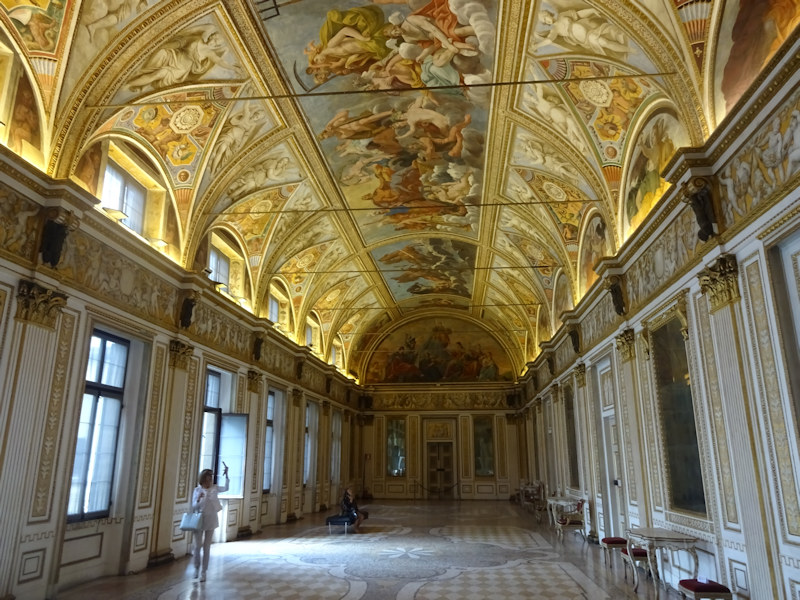
The Gallery of the Mirrors, originally built as a loggia in 1618
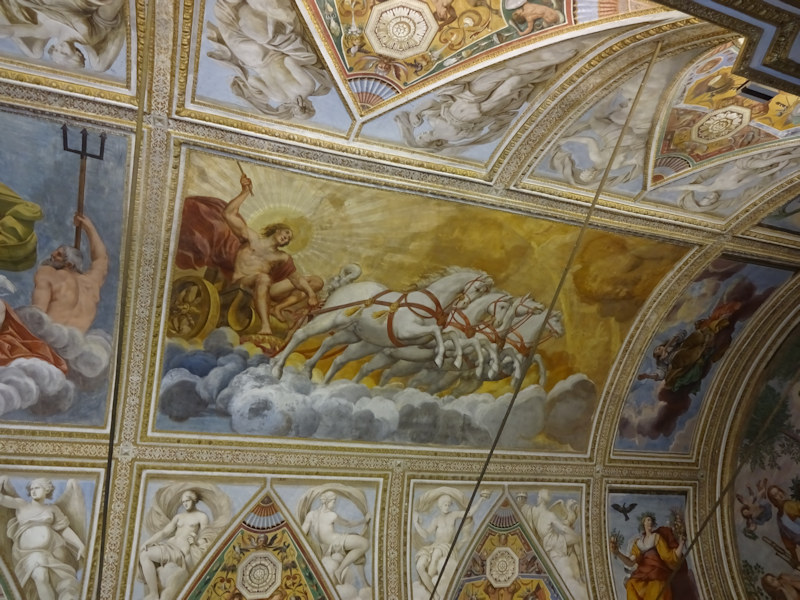
Daytime
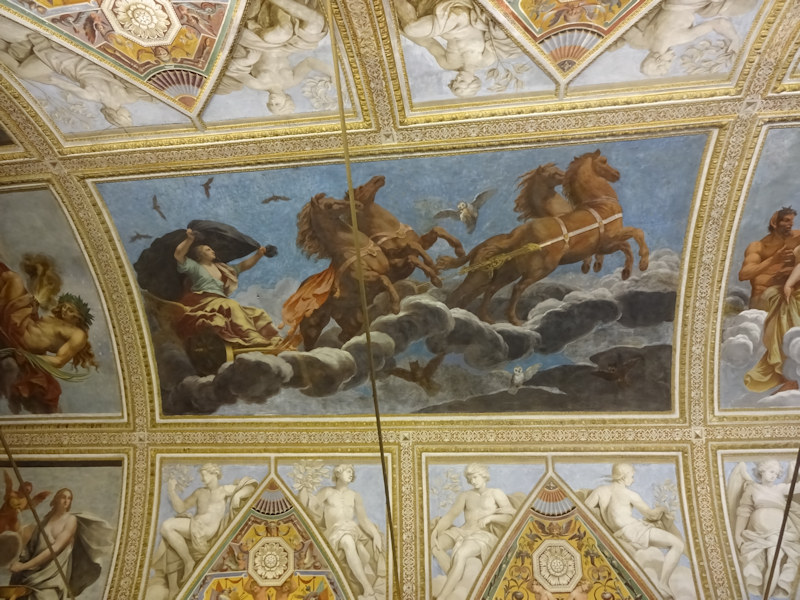
Nighttime
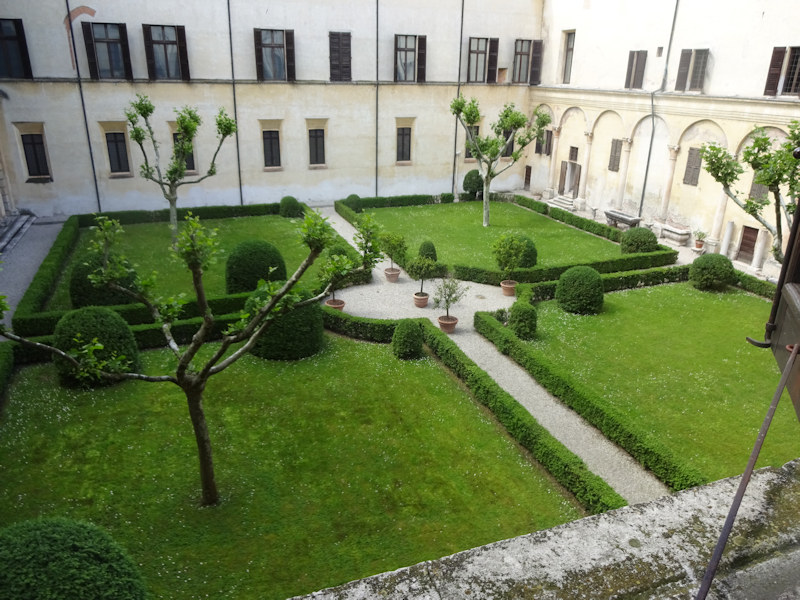
The garden behind the Magna Domus; a 15th century stroll in the gardens must have felt like exercise hour in the prison yard.
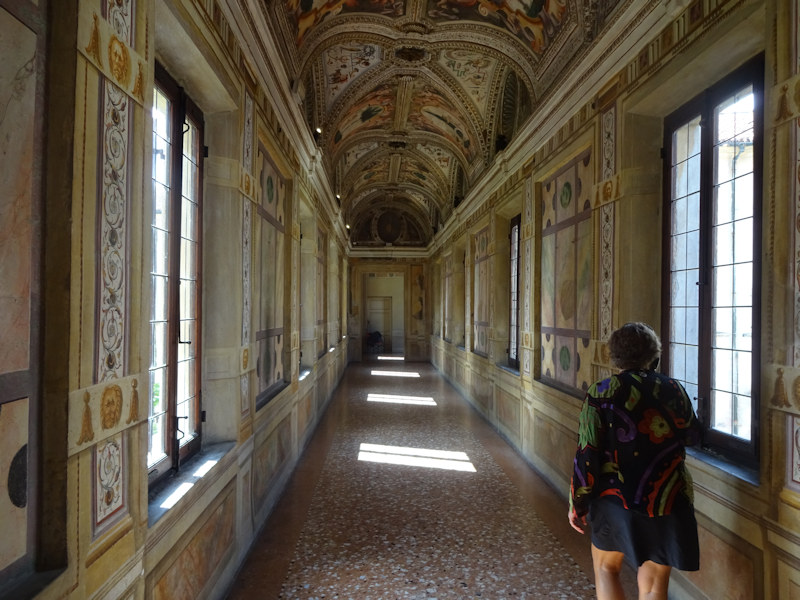
The Corridor of the Moors, originally just a passageway connecting the Corte Vecchia with the 15th century Domus Nova building
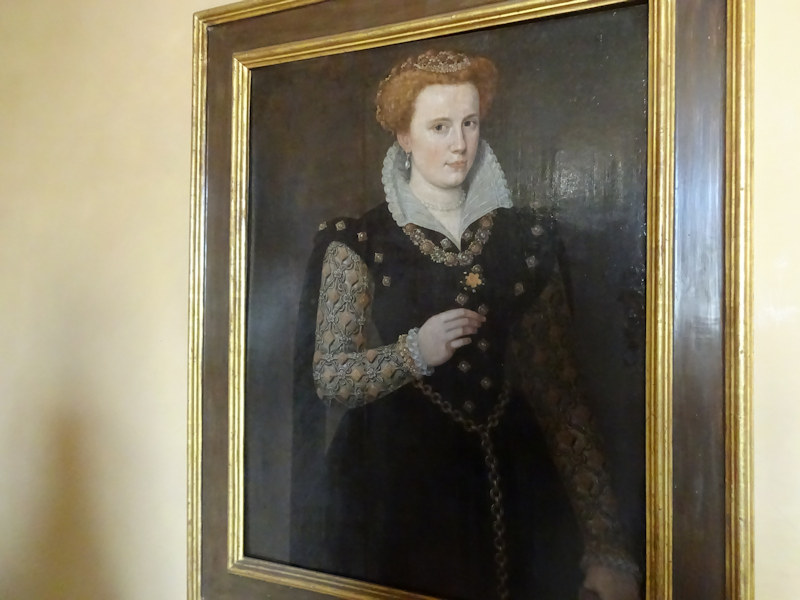
This is thought to be a portrait of Jane Dormer, one of "Bloody Mary's" ladies at the English court as a teenager, who married King Philip II's ambassador in London, the Duke of Feria, and on the Queen's death in 1558 moved to Spain and spoke up for persecuted English Catholics until her death in 1612. By Giovanni Bahuet, late 16th century.
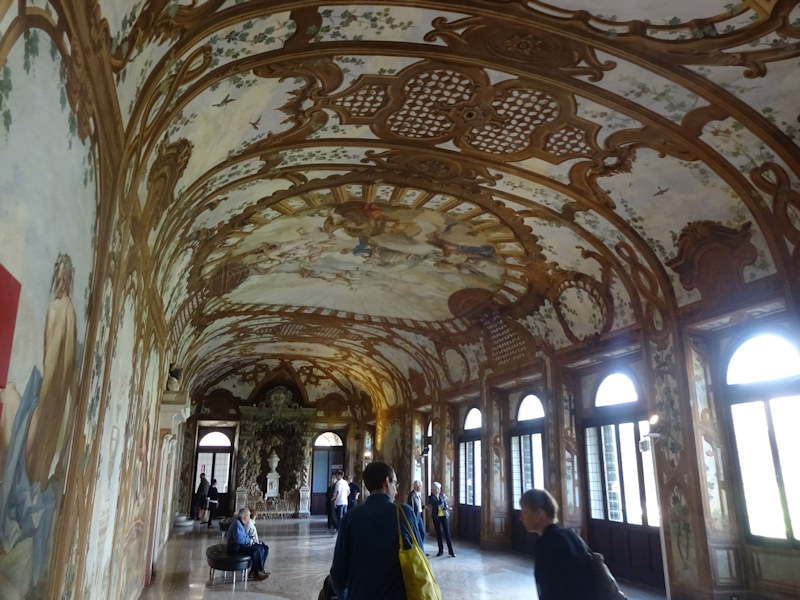
A kind of ballroom, apparently, built around 1580 . . .
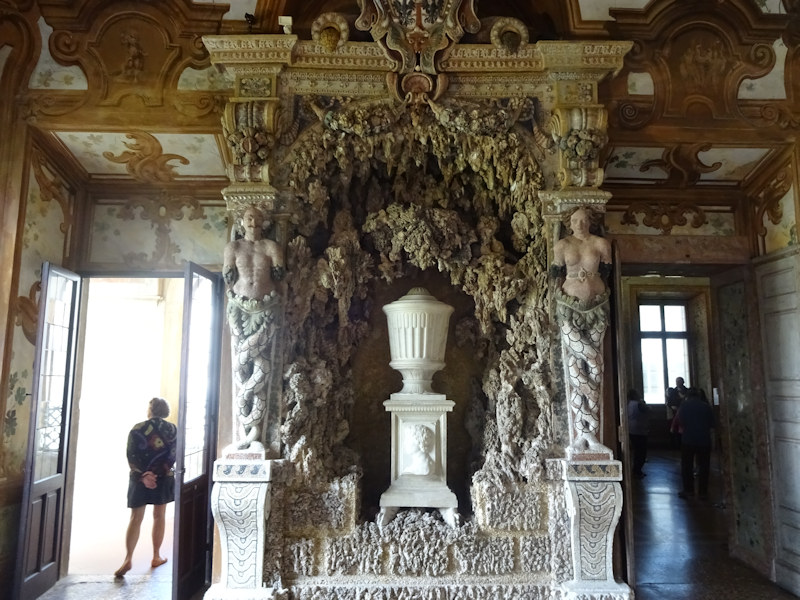
. . . with at the end of it, a grotto (there's one at each end, one from 1622, the other, Napoleonic from the late 18th century, and which one this is will await a better guidebook).
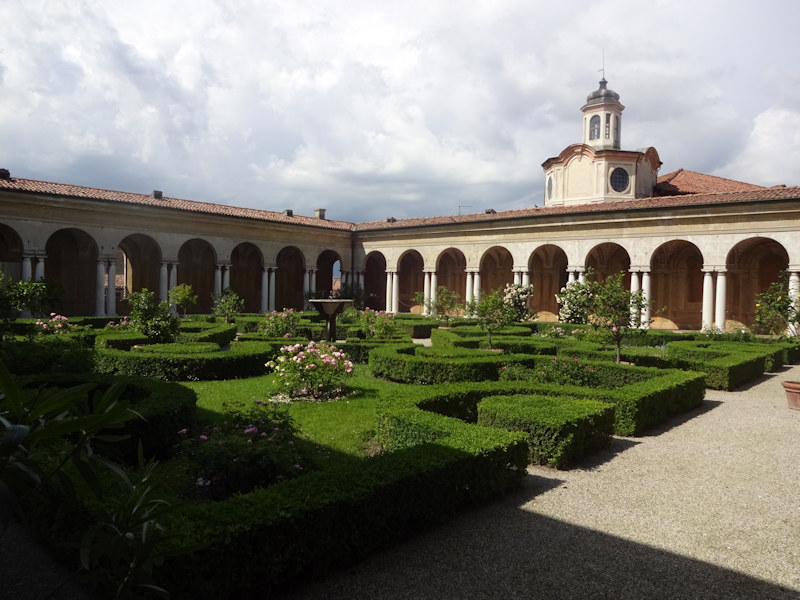
A kind of cloister and garden between the Magna Domus or main building and the Castello of St George
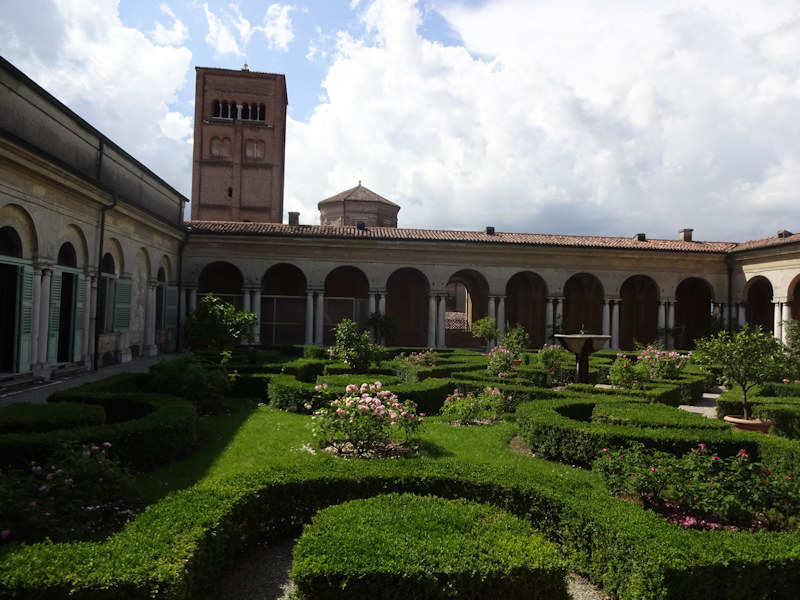
More Mantua here
      
     
  

 Feedback
and suggestions are welcome if positive, resented if negative, Feedback
and suggestions are welcome if positive, resented if negative,  .
All rights reserved, all wrongs avenged. Posted 29 July 2016. .
All rights reserved, all wrongs avenged. Posted 29 July 2016.
|
 Dwight Peck's personal website
Dwight Peck's personal website

































































